Simulation and Protection of Lightning Electromagnetic Pulse in Non-Metallic Nacelle of Wind Turbine
Abstract
:1. Introduction
2. Modeling Method
2.1. Principle of Transmission Line Modeling Method
2.2. Modeling of the Wind Turbine Nacelle
3. Simulating Result and Analysis
3.1. Calculated LEMP inside Nacelle
3.2. Influence of the Mesh Size on the Shielding Effect
3.3. Influence of the Mesh Material on the Shielding Effect
4. Conclusions
- (1)
- When lightning strikes at the air terminal of the wind turbine nacelle, high transient voltage is induced in the cables inside the nacelle. Applying metallic mesh to the nacelle shell can effectively reduce the magnetic field inside the nacelle as well as the transient voltage in the cable.
- (2)
- The mesh material will obviously influence the shielding effect. The shielding effect of an aluminum mesh nacelle is nearly 30 dB higher than that of a steel mesh nacelle because of the higher conductivity of the aluminum mesh material.
- (3)
- The shielding effect is proportional to the mesh side length and the smaller mesh size has better shielding effect against the magnetic field and generates lower transient voltage in the cable. For example, the mesh with the side lengths is 2 cm has a five times shielding effect than the mesh with 5 cm side lengths.
Author Contributions
Funding
Conflicts of Interest
References
- Zeng, R.; Zhuang, C.; Zhou, X.; Chen, S.; Wang, Z.; Yu, Z.; Jinliang, H. Survey of recent progress on lightning and lightning protection research. High Volt. 2016, 1, 2–10. [Google Scholar] [CrossRef]
- Wang, H.; Chen, Y.Z.; Wan, H.J.; Wang, X.J. Study on Coupling between Lightning Electromagnetic Field and Twisted Pair. J. Microw. 2014, 40, 1605–1613. [Google Scholar]
- Liu, S.H.; Liu, W.D. Progress of relevant research on electromagnetic compatibility and electromagnetic protection. High Volt. Eng. 2014, 40, 1605–1613. [Google Scholar]
- Zhou, Q.; Cheng, Y.; Bian, X.; Liu, F.; Zhao, Y. Analysis of Restrike Overvoltage of Circuit Breakers in Offshore Wind Farms. IEEE Trans. Appl. Supercond. 2016, 26, 1–5. [Google Scholar] [CrossRef]
- Yamamoto, K.; Noda, T.; Yokoyama, S.; Ametani, A. Experimental and analytical studies of lightning overvoltage in wind turbine generator systems. Electr. Power Syst. Res. 2009, 79, 436–442. [Google Scholar] [CrossRef]
- Zhou, Q.B.; Liu, C.X.; Bian, X.Y.; Lo, K.L.; Li, D.D. Numerical analysis of lightning attachment to wind trubine blade. Renew. Energy 2018, 116, 584–593. [Google Scholar] [CrossRef]
- Ma, Y.F.; Zhang, L.; Yan, J.Y.; Guo, Z.; Li, Q.; Fang, Z.; Siew, W.H. Inception mechanism of lightning upward leader from the wind turbine blade and a proposed critical length criterion. Proc. CSEE 2016, 36, 5975–5982. [Google Scholar]
- Gomes, C.; Cooray, V. On Theoretical Approaches to Estimate the Lightning Return Stroke Current Parameters. In Proceedings of the 11th International Symposium on High-Voltage Engineering (ISH 99), London, UK, 23–27 August 1999; p. v2-401. [Google Scholar]
- Petrache, E.; Paolone, M.; Rachidi, F.; Nucci, C.A.; Rakov, V.A.; Uman, M.; Jordan, D.; Rambo, K.; Schoene, J.; Cordier, A.; Verhaege, T. Measurement of Lightning-Induced Currents in an Experimental Coaxial Buried Cable. In Proceedings of the 2003 IEEE Power Engineering Society General Meeting, Toronto, ON, Canada, 13–17 July 2003. [Google Scholar]
- Zhou, C.Y. Analysis and protection of lightning shielding failure of wind turbine. Insul. Surge Arresters 2017, 1, 77–81. [Google Scholar]
- Wen, X.S.; Qu, L.; Wang, Y.; Si, T.; Xu, J.; Lan, L. Experimental study of the influence of the blade rotation on triggered lightning ability of wind turbine’s blades. Proc. CSEE 2017, 37, 2151–2158. [Google Scholar]
- Chen, W.J.; He, H.X.; He, J.J.; Zhao, X.; Yu, H.; Shi, W.; He, T. On the 3-dimentional leader progression model for the lightning shielding failure performance estimation of overhead transmission lines. Proc. CSEE 2014, 34, 6601–6612. [Google Scholar]
- Liu, G.; Xi, Y.; Tang, J.; Xi, Y.; Li, H.; Deng, L.; Xu, Z. Influence of triggered lightning of high voltage overhead transmission lines on 10 kV overhead distribution lines lightning trip characteristics. High Volt. Eng. 2014, 40, 690–697. [Google Scholar]
- Yu, H.; Dong, W.S.; Chen, S.D.; Wang, J.G.; Zhang, Y.J.; Zhang, Y.; Zhou, M.; Sun, Z.; Deqing, C.M. Observation and analysis of lightning induced overvoltage on buried cables. High Power Laser Part. Beams 2010, 22, 2373–2377. [Google Scholar] [CrossRef]
- Yang, B.; Zhou, B.H.; Chen, B.; Wang, J.B.; Meng, X. Numerical Study of Lightning-Induced Currents on Buried Cables and Shield Wire Protection Method. IEEE Trans. Electromagn. Compat. 2012, 54, 323–331. [Google Scholar] [CrossRef]
- Wind Turbines, Part 24 Lightning Protection: IEC 61400-24:2010; International Electrotechnical Commission: Geneva, Switzerland, 2010.
- Jojns, P.B.; Beurle, R.L. Numerical solution of 2-dimensional scattering problems using a transmission-line matrix. Proc. Inst. Electr. Eng. IET 1971, 118, 1203–1208. [Google Scholar]
- Hoefer, W.J.R. The Transmission-Line Matrix Method—Theory and Applications. IEEE Trans. Microw. Theory Tech. 1985, 33, 882–893. [Google Scholar] [CrossRef]
- Trenkic, V.; Christopoulos, C.; Benson, T.M. New symmetrical super-condensed node for the TLM method. Electr. Lett. 1994, 30, 329–330. [Google Scholar] [CrossRef]
- Johns, P.B. A Symmetrical Condensed Node for the TLM Method. IEEE Trans. Microw. Theory Tech. 1987, MTT-35, 370–377. [Google Scholar] [CrossRef]
- Johns, D.P.; Mallik, A.; Wlosarcyzk, A.J. TLM enhancements for EMC studies. In Proceedings of the 1992 Regional Symposium on Electromagnetic Compatibility, Tel-Aviv, Israel, 2–5 November 1992. [Google Scholar]
- Protection Against Lightning, Part 1 General Principles: IEC 62305-1:2010; International Electrotechnical Commission: Geneva, Switzerland, 2010.
- Zhang, X.Q. Lightning Protection and Ground Connection of Wind Turbines; China Electric Power Press: Beijing, China, 2009; pp. 20–22. [Google Scholar]
- Gong, X.H.; He, J.L.; Li, Y. Analysis on transient electromagnetic environment of substations. High Volt. Appar. 2009, 45, 39–43. [Google Scholar]
- Wang, X.H. Investigations on the Electromagnetic Effects in Wind Turbines Struck by Lightning; Jiao Tong University: Beijing, China, 2010. [Google Scholar]
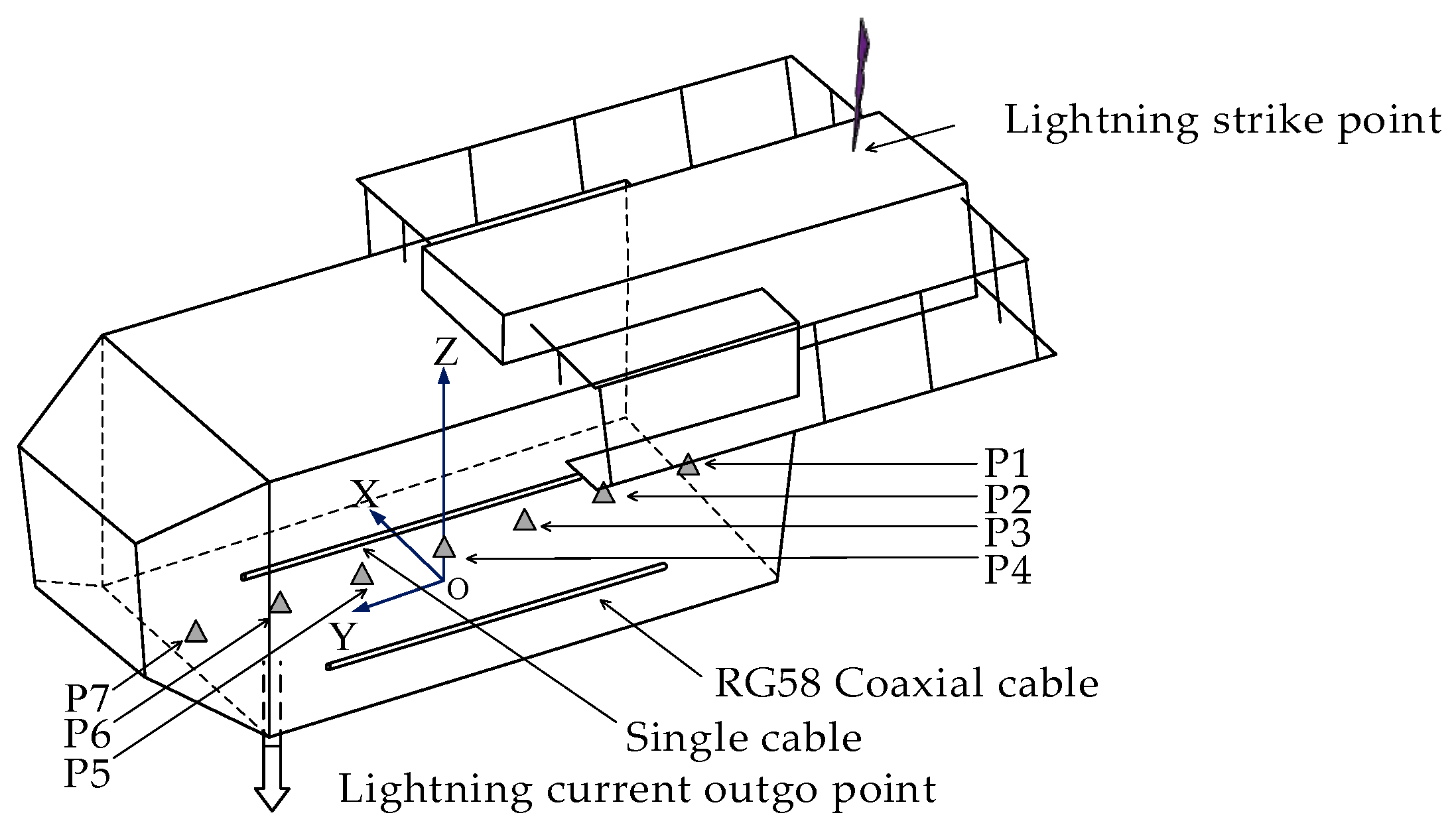

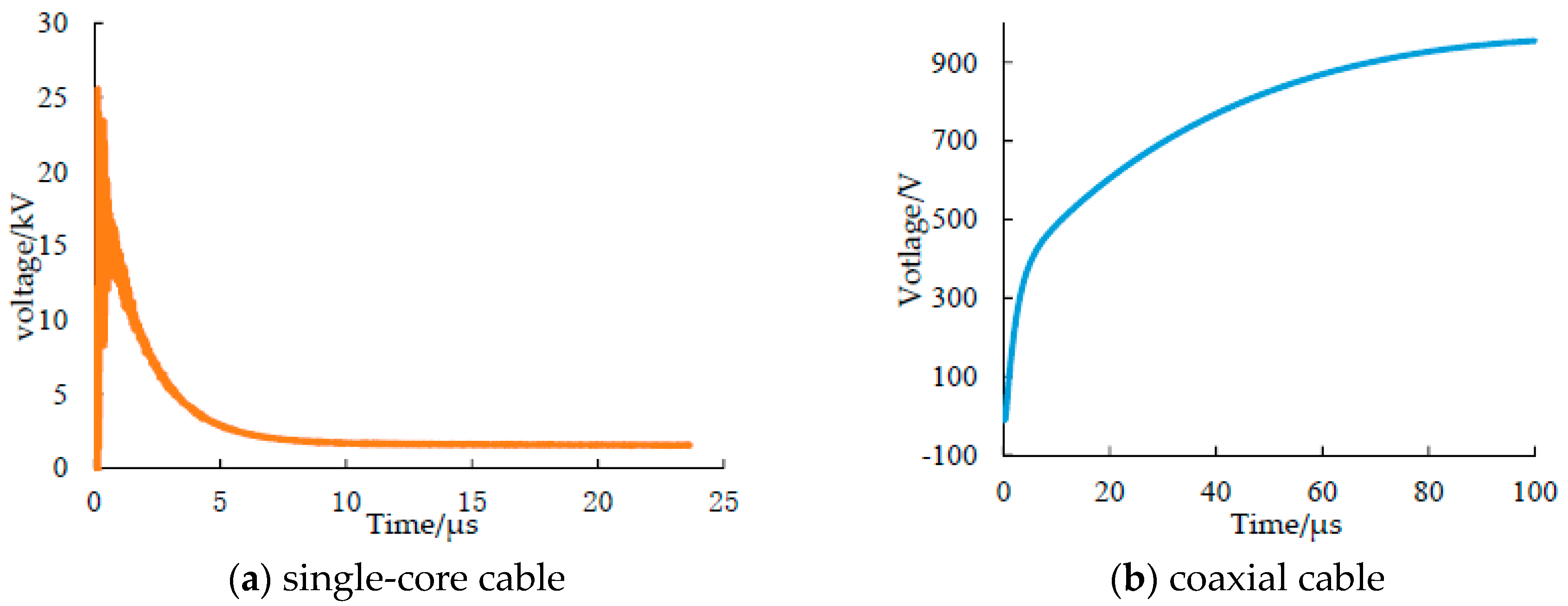


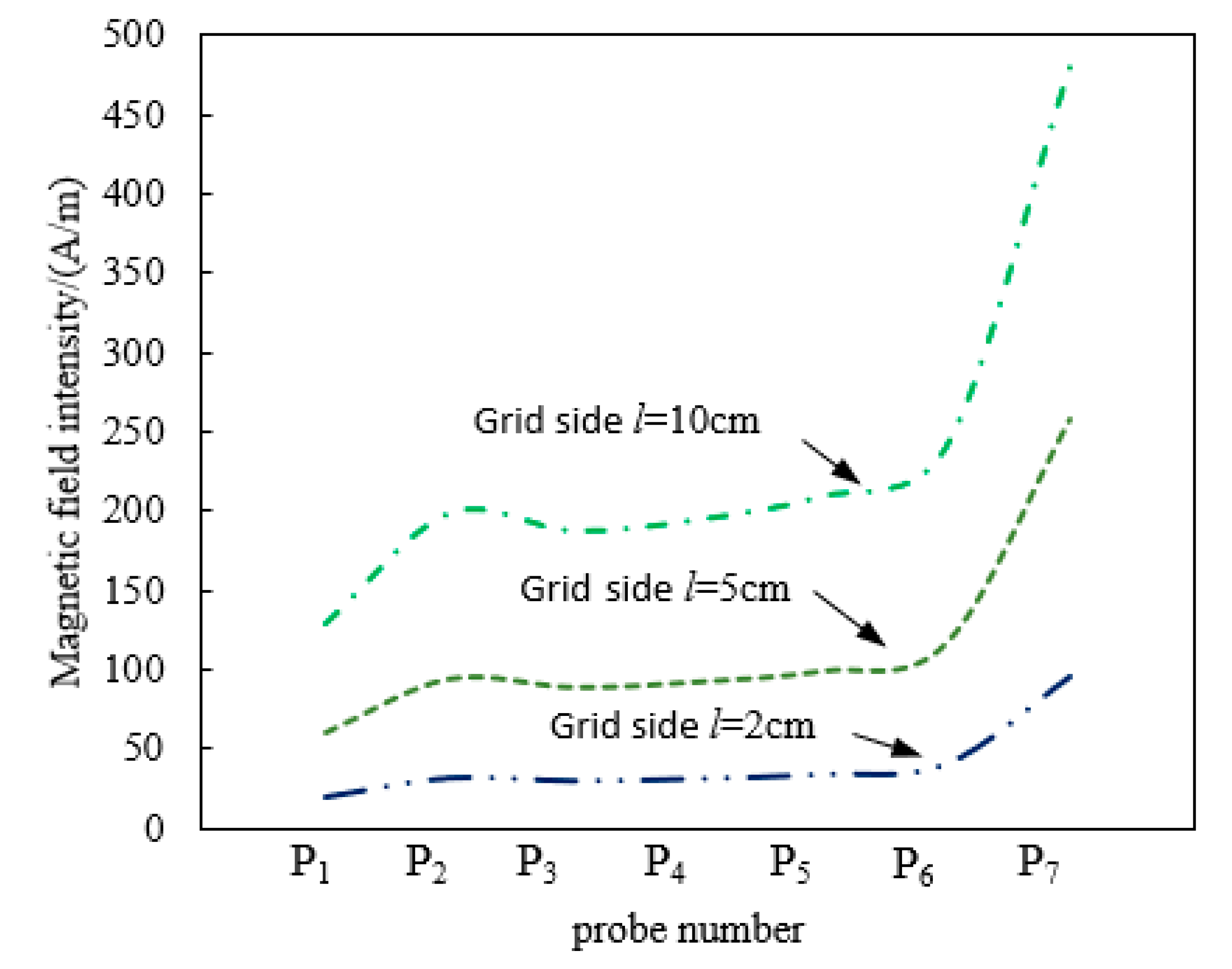
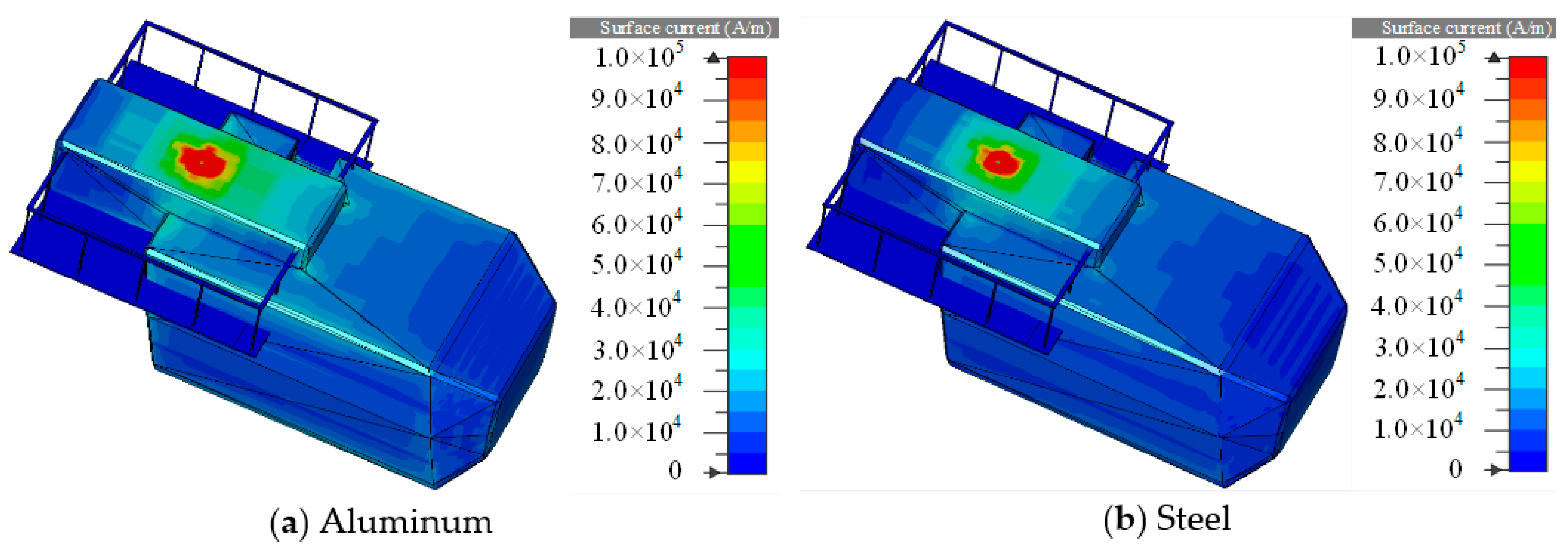
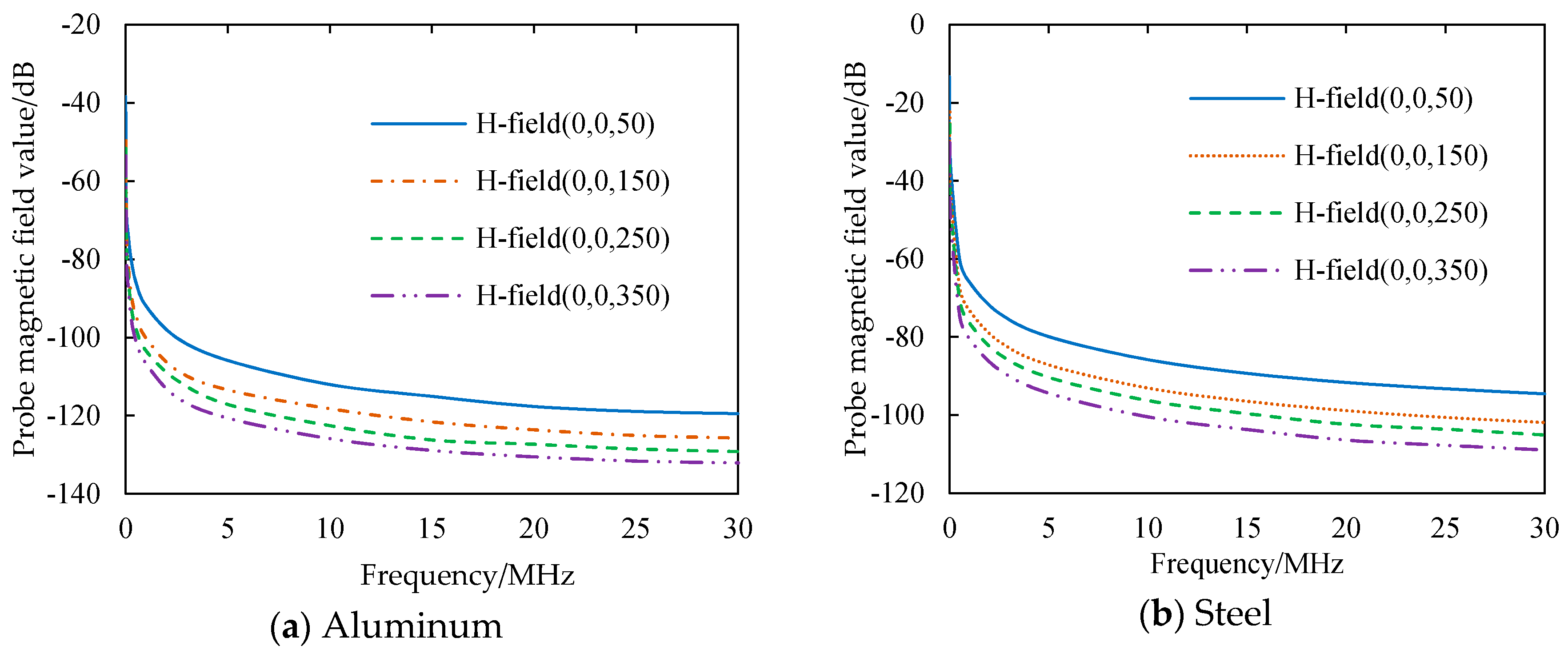
© 2019 by the authors. Licensee MDPI, Basel, Switzerland. This article is an open access article distributed under the terms and conditions of the Creative Commons Attribution (CC BY) license (http://creativecommons.org/licenses/by/4.0/).
Share and Cite
Zhou, Q.; Shi, Y.; Bian, X.; Zhou, B. Simulation and Protection of Lightning Electromagnetic Pulse in Non-Metallic Nacelle of Wind Turbine. Energies 2019, 12, 1745. https://doi.org/10.3390/en12091745
Zhou Q, Shi Y, Bian X, Zhou B. Simulation and Protection of Lightning Electromagnetic Pulse in Non-Metallic Nacelle of Wind Turbine. Energies. 2019; 12(9):1745. https://doi.org/10.3390/en12091745
Chicago/Turabian StyleZhou, Qibin, Yize Shi, Xiaoyan Bian, and Bo Zhou. 2019. "Simulation and Protection of Lightning Electromagnetic Pulse in Non-Metallic Nacelle of Wind Turbine" Energies 12, no. 9: 1745. https://doi.org/10.3390/en12091745
APA StyleZhou, Q., Shi, Y., Bian, X., & Zhou, B. (2019). Simulation and Protection of Lightning Electromagnetic Pulse in Non-Metallic Nacelle of Wind Turbine. Energies, 12(9), 1745. https://doi.org/10.3390/en12091745



